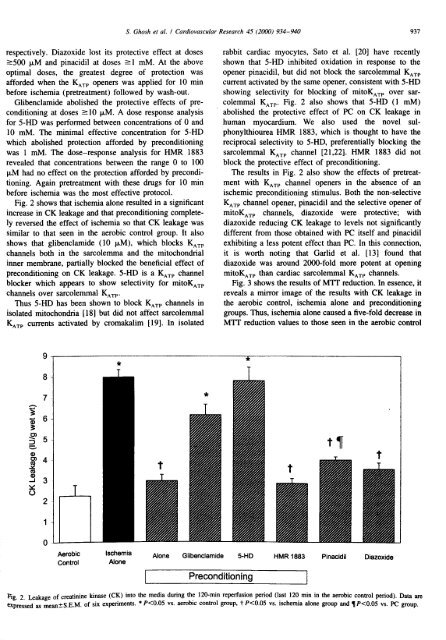ischaemic preconditioning of the human heart. - Leicester Research ...
ischaemic preconditioning of the human heart. - Leicester Research ...
ischaemic preconditioning of the human heart. - Leicester Research ...
You also want an ePaper? Increase the reach of your titles
YUMPU automatically turns print PDFs into web optimized ePapers that Google loves.
espectively. Diazoxide lost its protective effect at doses<br />
-500 jiM and pinacidil at doses ýI mM. At <strong>the</strong> above<br />
optimal doses, <strong>the</strong> greatest degree <strong>of</strong> protection was<br />
afforded when <strong>the</strong> KATP openers was applied for 10 min<br />
before ischernia (pretreatment) followed by wash-out.<br />
Glibenclamide abolished <strong>the</strong> protective effects <strong>of</strong> pre-<br />
conditioning at doses ý! 10 RM. A dose response analysis<br />
for 5-HD was performed between concentrations <strong>of</strong> 0 and<br />
10 mM. The minimal effective concentration for 5-HD<br />
which abolished protection afforded by <strong>preconditioning</strong><br />
was I mM. The dose-response analysis for HMR 1883<br />
revealed that concentrations between <strong>the</strong> range 0 to 100<br />
ýLM had no effect on <strong>the</strong> protection afforded by precondi-<br />
tioning. Again pretreatment with <strong>the</strong>se drugs for 10 min<br />
before ischernia was <strong>the</strong> most effective protocol.<br />
Fig. 2 shows that ischemia alone resulted in a significant<br />
increase in CK leakage and that <strong>preconditioning</strong> complete-<br />
ly reversed <strong>the</strong> effect <strong>of</strong> ischernia so that CK leakage was<br />
similar to that seen in <strong>the</strong> aerobic control group. It also<br />
shows that glibenclamide (10 RM), which<br />
S. Ghosh et al. / Cardiovascular <strong>Research</strong> 45 (2000) 934-940<br />
blocks KITP<br />
channels both in <strong>the</strong> sarcolemma and <strong>the</strong> mitochondrial<br />
inner membrane, partially blocked <strong>the</strong> beneficial effect <strong>of</strong><br />
<strong>preconditioning</strong> on CK leakage. 5-HD is a KATP channel<br />
blocker which appears to show selectivity for mitoKATP<br />
channels over sarcolemmal KATP*<br />
Thus 5-HD has been shown to block KATP channels in<br />
isolated rnitochondria [181 but did not affect sarcolemmal<br />
KATP currents activated by cromakalim [191. In isolated<br />
r_<br />
0<br />
cn<br />
Co<br />
Je<br />
(0<br />
9<br />
8<br />
7<br />
2<br />
1<br />
0<br />
Aerobic<br />
Control<br />
Ischemia<br />
Alone<br />
937<br />
rabbit cardiac myocytes, Sato et al. [20] have recently<br />
shown that 5-HD inhibited oxidation in response to <strong>the</strong><br />
opener pinacidil, but did not block <strong>the</strong> sarcolemmal K,,,<br />
current activated by <strong>the</strong> same opener, consistent with 5-HD<br />
showing selectivity for blocking <strong>of</strong> mitoKITP over sar-<br />
colernmal KATP, Fig. 2 also shows that 5-HD (I mM)<br />
abolished <strong>the</strong> protective effect <strong>of</strong> PC on CK leakage in<br />
<strong>human</strong> myocardium. We also used <strong>the</strong> novel sul-<br />
phonylthiourea HMR 1883, which is thought to have <strong>the</strong><br />
reciprocal selectivity to 5-HD, preferentially blocking <strong>the</strong><br />
sarcolemmal KATP channel [21,22]. HMR 1883 did not<br />
block <strong>the</strong> protective effect <strong>of</strong> <strong>preconditioning</strong>.<br />
The results in Fig. 2 also show <strong>the</strong> effects <strong>of</strong> pretreat-<br />
ment with KATP channel openers in <strong>the</strong> absence <strong>of</strong> an<br />
ischemic <strong>preconditioning</strong> stimulus. Both <strong>the</strong> non-selective<br />
KATP channel opener, pinacidil and <strong>the</strong> selective opener <strong>of</strong><br />
mitoKATP channels, diazoxide were protective; with<br />
diazoxide reducing CK leakage to levels not significantly<br />
different from those obtained with PC itself and pinacidil<br />
exhibiting a less potent effect than PC. In this connection,<br />
it is worth noting that Garlid et al. [13] found that<br />
diazoxide was around 2000-fold more potent at opening<br />
mitoKATP than cardiac sarcolemmal KATP channels.<br />
Fig. 3 shows <strong>the</strong> results <strong>of</strong> MTT reduction. In essence, it<br />
reveals a mirror image <strong>of</strong> <strong>the</strong> results with CK leakage in<br />
<strong>the</strong> aerobic control, ischernia alone and <strong>preconditioning</strong><br />
groups. Thus, ischernia alone caused a five-fold decrease in<br />
MTT reduction values to those seen in <strong>the</strong> aerobic control<br />
Alone Glibenclamide 5-HD HMR 1883 Pinacidil Diazoxide<br />
I Preconditioning<br />
Pig. 2. Leakage <strong>of</strong> creatinine kinase (CK) into <strong>the</strong> media during <strong>the</strong> 120-min reperfusion period (last 120 min in <strong>the</strong> aerobic control period). Data are<br />
expressed as mean±S. E. M. <strong>of</strong> six experiments. * P














